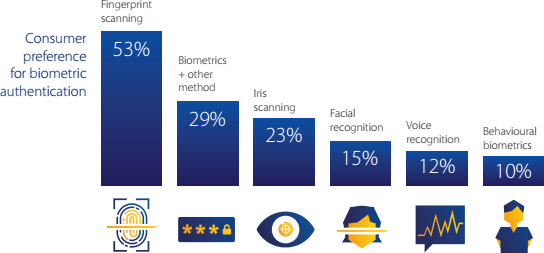OOPS! You forgot to upload swfobject.js ! You must upload this file for your form to work.
Europeans most trusted fingerprint sensors with identification
![]()
|
xtreview is your : Video card - cpu - memory - Hard drive - power supply unit source |
|
|||
|
|
||||
 Recommended : Free unlimited image hosting with image editor
Recommended : Free unlimited image hosting with image editor
|
POSTER: computer news || EUROPEANS MOST TRUSTED FINGERPRINT SENSORS WITH IDENTIFICATION |
DATE:2016-09-21 |
|
|
Today, fingerprint sensors that allow the user access to a mobile device by a unique pattern of papillary lines on a finger, found even in the mid-priced smartphones. Systems of information security experts have repeatedly demonstrated the ways of cheating such sensors, but they are quite complex for mass reproduction. According to colleagues from the site Tom's Hardware Guide, conducted by the payment system VISA poll found that Europeans trust fingerprint identification more than other biometric authentication techniques. Modern smartphones have learned to identify the person, not only the face but also on the image of the iris. Such methods are not yet in high esteem among residents of Europe, as shown by VISA survey, but it should be borne in mind that the person can have more confidence in the technology that it has already had time to test, and fingerprint sensors gained more widespread than the more exotic methods of identification.
The older audience, the more likely respondents are ready to replace the password protection on fingerprint authentication. At the same time, young people are willing to pay for purchases in shops, confirming the identity of the fingerprint. Overall, 73% of respondents are inclined to believe that the most reliable way to protect sensitive data would be two-factor security, which includes biometric identification. For example, the fingerprint would be supplemented by a one-time password or code. Banks respondents tend to trust their information more likely (57%) than the government (33%). However, we should not forget that the government has enough leverage over the banks. Related Products : | ||
|
|
||
|
xtreview is your : Video card - cpu - memory - Hard drive - power supply unit source |
|
|
|
|
||
|
Xtreview Support  N-Post:xxxx Xtreview Support        |
EUROPEANS MOST TRUSTED FINGERPRINT SENSORS WITH IDENTIFICATION |
| Please Feel Free to write any Comment; Thanks  |
Europeans presented a promising framework for the 5-nm transistors (2016-12-10)
Europeans will be able to take the electric Tesla Model S on a weekly test drive (2016-11-21)
Europeans most trusted fingerprint sensors with identification (2016-09-21)
![]()
To figure out your best laptops .Welcome to XTreview.com. Here u can find a complete computer hardware guide and laptop rating .More than 500 reviews of modern PC to understand the basic architecture


7600gt review
7600gt is the middle card range.
We already benchmarked this video card and found that ...

 geforce 8800gtx and 8800gts
geforce 8800gtx and 8800gts  Xtreview software download Section
Xtreview software download Section  AMD TURION 64 X2 REVIEW
AMD TURION 64 X2 REVIEW  INTEL PENTIUM D 920 , INTEL PENTIUM D 930
INTEL PENTIUM D 920 , INTEL PENTIUM D 930  6800XT REVIEW
6800XT REVIEW  computer hardware REVIEW
computer hardware REVIEW  INTEL CONROE CORE DUO 2 REVIEW VS AMD AM2
INTEL CONROE CORE DUO 2 REVIEW VS AMD AM2  INTEL PENTIUM D 805 INTEL D805
INTEL PENTIUM D 805 INTEL D805  Free desktop wallpaper
Free desktop wallpaper  online fighting game
online fighting game  Xtreview price comparison center
Xtreview price comparison center Lastest 15 Reviews


Rss Feeds
Last News
- The new version of GPU-Z finally kills the belief in the miracle of Vega transformation
- The motherboard manufacturer confirms the characteristics of the processors Coffee Lake
- We are looking for copper coolers on NVIDIA Volta computing accelerators
- Unofficially about Intels plans to release 300-series chipset
- The Japanese representation of AMD offered monetary compensation to the first buyers of Ryzen Threadripper
- This year will not be released more than 45 million motherboards
- TSMC denies the presentation of charges from the antimonopoly authorities
- Radeon RX Vega 64 at frequencies 1802-1000 MHz updated the record GPUPI 1B
- AMD itself would like to believe that mobile processors Ryzen have already been released
- AMD Vega 20 will find application in accelerating computations
- Pre-orders for new iPhone start next week
- Radeon RX Vega 57, 58 and 59: the wonders of transformation
- ASML starts commercial delivery of EUV-scanners
- The older Skylake processors with a free multiplier are removed from production
- Meizu will release Android-smartphone based on Helio P40
- AMD Bristol Ridge processors are also available in American retail
- The fate of Toshiba Memory can be solved to the next environment
- duo GeForce GTX 1080 Ti in GPUPI 1B at frequencies of 2480-10320 MHz
- New Kentsfield overclocking record up to 5204 MHz
- Lenovo released Android-smartphone K8

HALO 3 HALO 3 - Final Fight!

PREY Prey is something you don t often see anymore: a totally unigue shooter experience.

computer news computer parts review Old Forum Downloads New Forum Login Join Articles terms Hardware blog Sitemap Get Freebies



